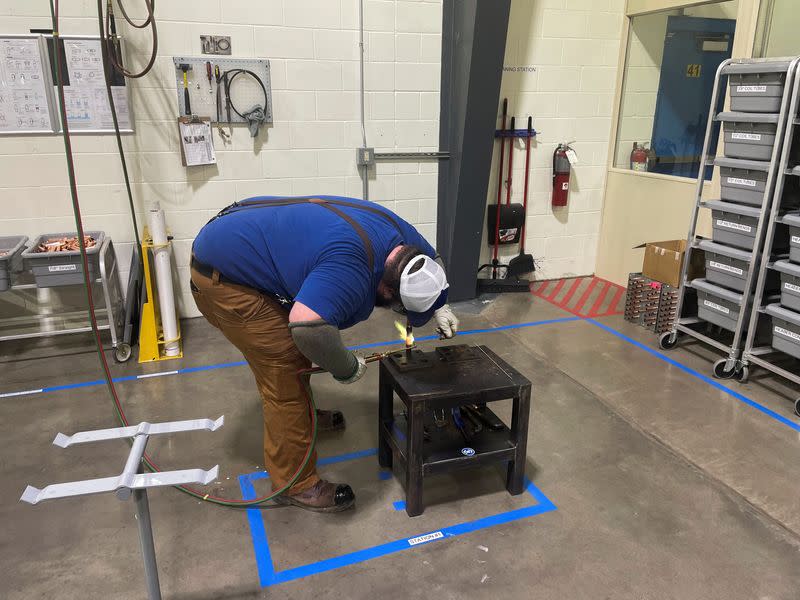Perfect storm in Minnesota labor market is worrying harbinger for the Fed
By Howard Schneider
FARIBAULT, Minnesota (Reuters) - Demand for Daikin Applied Americas Inc's climate control equipment is soaring, and worker recruitment is in hyperdrive, with hiring trips to women's shelters and immigrant support groups and an open door for applicants with no high school degree or manufacturing experience.
For Minnesota's healthcare industry, an estimated 5,000 open nursing positions have sparked the invention of a new specialty, the nurse retentionist who is focused on convincing colleagues to stay on the job. It has also prompted talk of capping workloads and led to up to an 18% pay increase over three years for unionized nurses.
Government officials, worried about a constrained labor force in a state where population growth has stalled, have taken a cover-the-waterfront approach. That includes proposals for training in high-growth occupations and subsidies for accommodations at small businesses looking to hire workers with disabilities, efforts to pull members of minority groups off the employment sidelines, a push to reintegrate ex-offenders into the workforce, and grants to study how to speed occupational licensing for immigrants trained abroad.
"It's a pretty basic supply and demand curve," Jeff Drees, chief executive of the U.S. unit of Japan's Daikin Industries Ltd, said in an interview from the company's Faribault plant about 50 miles (80.5 km) south of Minneapolis. "We will hire as many as we can take right now ... because every employee we bring on will just help us reduce our lead time."
After raising starting wages from $17 an hour to around $24 and overhauling hiring strategies, Drees still has 200 open jobs at this and two nearby facilities, where he is hoping to add to current staffing of 1,200. Daikin's order book is bulging, he said, amid demand driven by buildings being upgraded with better air conditioning systems in the wake of the COVID pandemic, a rush of new data centers and electric vehicle plants, and federal dollars flowing under recent infrastructure and environmental legislation.
To Federal Reserve officials wondering when wage growth might slow as they try to cool the economy and inflation, his prognosis is not soon. "I don't think it's leveling off."
(Listen to a related podcast here: )
Graphic: The jobs mismatch - https://www.reuters.com/graphics/USA-ECONOMY/LABOR/klvygbbjkvg/chart.png
WORKER DEMAND
Labor shortages have plagued the U.S. since the first months of the pandemic. Initially, reopened businesses found workers reluctant to return to jobs because of health concerns and an ability to wait it out because of pandemic relief payments, enhanced unemployment insurance and other programs.
As health fears eased and support programs lapsed, a realization set in that the pandemic had realigned American work, from the occupations in demand to the willingness of people to do them.
That reshuffling may be one reason the Fed is finding it harder than expected to slow a job market struggling to match workers into open positions. It also may mute any job losses from U.S. central bank efforts to curb overall demand and tame inflation.
Recent Bureau of Labor Statistics data suggest that while some key occupational gaps were driven by the pandemic, others were well-established when the health crisis struck in 2020, and continue to fuel the high demand for workers the Fed wants to ease.
Some of those gaps may eventually respond to Fed efforts to slow the economy. Food preparation and service jobs, for example, fell by about 1 million from 2019 to 2022, the BLS data shows. But the industry's high rate of job openings - more than 8% of potential positions were open as of February - shows firms are still trying to attract employees. If a Fed-induced slowdown causes households to cut down on restaurant meals, hiring pressure should ease.
The dislocation, though, is nearly as bad for services like healthcare, where spending is less by choice and demand, and thus less influenced by economic conditions. Healthcare employment surged by 3 million from 2016 to 2019, before the pandemic, and by another 463,000 from 2019 to 2022. Yet the industry's job openings rate remains above 7%.
Graphic: Job openings to unemployed - https://www.reuters.com/graphics/USA-ECONOMY/VACANCIES/zdpxobkxmvx/chart.png
'NEXT TO NO GROWTH'
Along with sectoral gaps, geographic ones exist as well.
The experience of Minnesota, where a strong industrial and corporate base has collided with flatlining population growth, suggests the process of finding a new balance, so central to the evolution of the economy, wages and inflation, will be neither fast nor cheap.
On the upside, there is some evidence for a hope shared by many Fed officials that as the economy slows, companies will trim the current high level of job openings but not fire employees who may be hard to recruit back.
At roughly 10 million open positions nationally as of the end of February, there were about 1.7 jobs open for each of the roughly 5.9 million unemployed jobseekers, down from the peak of around 2-to-1 last year but well-above pre-pandemic levels.
Minnesota has had a particularly large imbalance: The 12-month moving average of available positions last year reached 2.75 for every unemployed person. That has edged down to around 2.6, yet the unemployment rate has remained at or below 3% since December 2021. The number of unemployed has risen since last year, but the three-month average has stabilized at about 90,000 since November - similar to the state's pre-pandemic lows.
Still, given the outlook from companies like Daikin or the chronic shortages seen across industries like healthcare, it remains unclear how fast or far labor demand will fall.
Supply, meanwhile, is likely to improve only slowly, if at all.
In a dilemma offering a glimpse of the country's future if birthrates and immigration remain low, companies are competing for workers from a labor pool little changed since 2017 and projected to see "next to no growth over the next decade," Minnesota State Demographer Susan Brower estimated in a February labor-force outlook.
The U.S. as a whole isn't there yet. But recent Congressional Budget Office projections estimated that by around 2040 the net number of births over deaths will approach zero, with any population increase from then the result of immigration.
Graphic: Minnesota job market - https://www.reuters.com/graphics/USA-ECONOMY/LABOR/lbvggzzzrvq/chart.png
PART-TIME NURSES
The situation has been great for job hunters and job switchers.
Juan Munhen moved to Faribault from Brazil last year to join his wife, who is originally from the city. Once his immigration documents and other papers were in order, things moved fast: nine days from his online application to receiving a job offer and a request to start as soon as possible.
For Anthony Clammer, the booming job market meant a switch that cut his commute from a previous job that was 40 minutes away by car, provided more flexibility to help care for his kids when needed, and offered a dependable first-shift schedule - a plum in the manufacturing sector.
"Nowadays you look online and there are just hundreds of day-shift job positions," he said. "I don't think in 2019 I would have gotten a day shift right away."
In areas of chronic shortage, like nursing, the battle is not just getting bodies into jobs but keeping them there. It has become an expensive proposition, particularly as worker preferences have changed during the pandemic, said Rahul Koranne, president and CEO of the Minnesota Hospital Association.
The number of nurses only willing to work part-time, he said, has surged from between 30% and 40% before the pandemic to 57% last year.
"Was that the pandemic? Maybe," Koranne said. "We also think it is generational," with younger employees wanting better work-life balance.
Since those part-time positions typically still carry full-time benefits, it drives up the cost of filling the equivalent of a full-time employee.
State officials acknowledge the problem is one of numbers, and are putting efforts into marketing in hopes of convincing people to move there.
But Steve Grove, who was until March the commissioner of the Minnesota Department of Employment and Economic Development, said the state can't count on a reversal of the population trends and must focus as well on reducing barriers for current residents.
"You have to get the number of warm bodies up," he said, but "there is not one silver bullet ... It is housing, training, benefits, retention. We are looking to be more assertive."
(Reporting by Howard Schneider; Editing by Dan Burns and Paul Simao)


